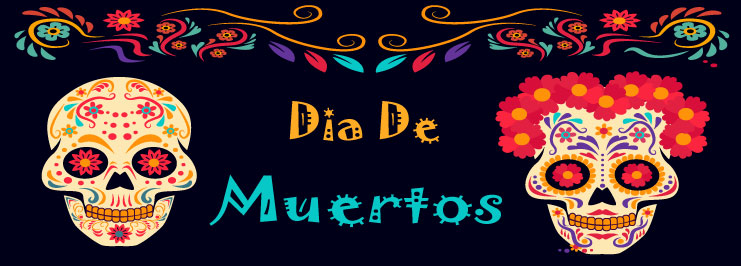
If there is a Mexican holiday which enjoys great international renown, without a doubt is the famous "Dia de Muertos" or "The Day of the Dead". The symbols are well-known: "The Catrina", a female skeleton greaciously wearing a gown and a colorful hat or flowers in her head; also her male counterpart, the "Catrin", the skeleton of a man in a black suit and hat. Another popular image is that of the "Calaverita de Azucar" or "Sugar Skull", which as its name indicates, it is a white sugar candy in the shape of a skull with shiny colored details. All these images, and many more, represent the idea of mexican ancestors coming back to life on this special day. They can, for a limited time, be found on our "Loteria Dia de Muertos", great way to have fun while learning about these mystical symbols.
As entretaining as these colorful depictions of the dead are, the real treat is in the rituals and traditions behind those images. It is mostly believed that the tradition was born with the arrival of the Spanish conquerors to Mexico in the 16th century. The pre-colonial civilizations in Mexico had their own concept of death and their celebrations, but when the Spanish brought their catholic rituals and mortuary ceremonies the celebration became something different, a mixture of two cultures, and gave place to what was later known as the mexican "Dia de Muertos".
The main part of the celebration takes place every year on the 2nd of November. This is the day where the dead come back to visit their families.During the day some mexican families go to the cementery to talk to their loved ones that have died, some will make a little party, take food and something to drink. Some will even take a Mariachi to sing the dead one's favourite songs. Every family have their own way of celebrating, but there is a tradition that most of the Mexicans participate in, and that is to build an "Altar de Muertos" or "Altar of the Dead".
The "Altar de Muertos" is not always done for family member who passe away. Altars are also made on schools, offices, houses, and any other place where people work together to remember someone they loved or admired. There are even some cases where funny Altars are made, in which they depict politicians, singers, teachers, writers, or anyone who is still alive, not as a bad omen, but just for fun. But the traditional Altar is made for a loved one, usually a family member. The popular belief is that the dead will come back to their families to talk, eat, drink, and sing. The family has to be prepared for this, that is why the Altar is made.
The "Altar de Muertos" has usually 7 different levels, altough these can change depending on the family building the Altar. The levels represent the steps that the soul of the dead has to take to reach spiritual peace. On these levels the family should put food, drinks, and objects that the dead one cherished during their live. It is common to see bread, tortillas, ham, tobacco, a game of domino, cards, a guitar, tequila, and many other things. What is almost visible on any altar are also mexican candies. One that has tasted mexican candy cannot forget their delicious flavor, from the spicy tamarindo-flavor "Ollita Rica" to the soft and sugary flavor of the "Masapan" or the fresh taste of the "Rollo de Coco". All of them sold at our "Dia de Muertos Candy Mix". It's no wonder how many candies are on these altars, considering people who tried them go crazy for them.
And so when the things that the dead will enjoy on their visit are placed on the Altar other elements are added. It is a tradition to have colorful paper figures hanging on top of the Altar. There is as well a representation of water, fire and earth. Water is representated with a glass of water so that the dead can quench their thirst, fire is represented with multiple candles, and ground is depicted as seeds and fruits. Also the altar is usually decorated with flowers, specially "Cempasúchil", a bright yellow flower which is placed as a pathway on the ground to guide the dead to their respective Altar. Some people play some music or light an incense to create a more festive atmosphere. But everyone celebrates this holiday happily because death is not seen only as the end of life, but as a passage to an afterlife, where every "Day of the Dead" families can be reunited, sing, dance, drink and eat the sweetest candy.

